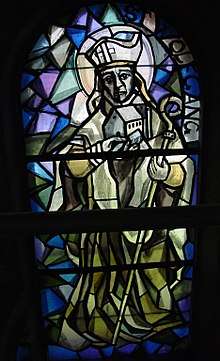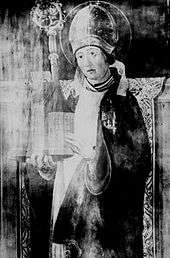Wolfgang of Regensburg
Saint Wolfgang of Regensburg (Latin: Wolfgangus; c. 934 – October 31, 994 AD) was bishop of Regensburg in Bavaria from Christmas 972 until his death. He is a saint of the Roman Catholic (canonized in 1052) and Eastern Orthodox churches. He is regarded as one of the three great German saints of the 10th century, the other two being Saint Ulrich and Saint Conrad of Constance. Towards the end of his life Wolfgang withdrew as a hermit to a solitary spot, in the Salzkammergut region of Upper Austria. Soon after Wolfgang's death many churches chose him as their patron saint, and various towns were named after him.
Saint Wolfgang | |
|---|---|
 Saint Wolfgang, stained glass, Parish Church in Leising | |
| The Almoner | |
| Born | c. 934 |
| Died | October 31, 994 |
| Venerated in | Roman Catholic Church Eastern Orthodox Church |
| Canonized | October 8, 1051 by Pope Leo IX |
| Feast | October 31 |
| Attributes | depicted with an axe in the right hand and the crozier in the left; or as a hermit in the wilderness being discovered by a hunter. |
| Patronage | apoplexy; carpenters and wood carvers; paralysis; Regensburg, Germany; stomach diseases; strokes |
Early life
Wolfgang was descended from the family of the Swabian Counts of Pfullingen (Mon. Germ. His.: Script., X, 53). When seven years old, he had an ecclesiastic as a tutor at home; later he attended the celebrated monastic school at Reichenau Abbey.[1] Here he formed a strong friendship with Henry of Babenberg, brother of Bishop Poppo of Würzburg, whom he followed to Würzburg in order to attend the lectures of the noted Italian grammarian, Stephen of Novara, at the cathedral school.
After Henry was made Archbishop of Trier in 956, he summoned Wolfgang, who became a teacher in the cathedral school of Trier, and also labored for the reform of the archdiocese,[1] despite the hostility with which his efforts were met. Wolfgang's residence at Trier greatly influenced his monastic and ascetic tendencies, as here he came into contact with the great reform monastery of the 10th century, St. Maximin's Abbey, Trier, where he made the acquaintance of Saint Romuald, the teacher of Saint Adalbert of Prague.
After the death of Archbishop Henry of Trier in 964, Wolfgang entered the Benedictine order in the Abbey of Maria Einsiedeln, Switzerland,[1] and was ordained priest by Saint Ulrich in 968.
Mission to the Magyars
After their defeat in the Battle of the Lechfeld (955), the heathen Hungarians settled in ancient Pannonia. As long as they were not converted to Christianity they remained a constant menace to the empire.
At the request of Ulrich, who clearly saw the danger, and at the desire of the Emperor Otto the Great, Wolfgang, according to the abbey annals, was "sent to the Hungarians" as the most suitable man to evangelize them.
He was followed by other missionaries sent by Piligrim, Bishop of Passau, under whose jurisdiction the new missionary region came.
Bishop of Regensburg

After the death of Bishop Michael of Regensburg (September 23, 972) Bishop Piligrim obtained from the emperor the appointment of Wolfgang as the new bishop (Christmas, 972). Wolfgang's services in this new position were of the highest importance, not only for the diocese, but also for the cause of civilization. As Bishop of Regensburg, Wolfgang became the tutor of Emperor Saint Henry II, who learned from him the principles which governed his saintly and energetic life.[2] Poppe, son of Margrave Luitpold, Archbishop of Trier (1018), and Tagino, Archbishop of Magdeburg (1004–1012), also had him as their teacher.
Wolfgang deserves credit for his disciplinary labours in his diocese. His main work in this respect was connected with the ancient and celebrated St. Emmeram's Abbey, which he reformed by granting it once more abbots of its own, thus withdrawing it from the control of the bishops of Regensburg, who for many years had been abbots in commendam, a condition of affairs that had been far from beneficial to the abbey and monastic life. In the Benedictine monk Romuald, whom Saint Wolfgang called from Saint Maximin at Trier, Saint Emmeram received a capable abbot (975).
The saint also reformed the convents of Obermünster and Niedermünster at Regensburg, chiefly by giving them as an example the convent of St. Paul, Mittelmünster, at Regensburg, which he had founded in 983. He also co-operated in the reform of the ancient and celebrated Benedictine Abbey of Niederaltaich, which had been founded by the Agilolfinger dynasty, and which from that time took on new life.
He showed genuine episcopal generosity in the liberal manner with which he met the views of the Emperor Otto II regarding the intended reduction in size of his diocese for the benefit of the new Diocese of Prague (975), to which Saint Adalbert was appointed first bishop. As prince of the empire he performed his duties towards the emperor and the empire with the utmost scrupulousness and, like Saint Ulrich, was one of the mainstays of the Ottonian policies.
He took part in the various imperial diets, and, in the autumn of 978, accompanied the Emperor Otto II on his campaign to Paris, and took part in the Diet of Verona in June 983. He was succeeded by Gebhard I.
Hermitage and death
Towards the end of his life Saint Wolfgang withdrew as a hermit to a solitary spot, now the Wolfgangsee ("Wolfgang's Lake") in the Salzkammergut region of Upper Austria, apparently on account of a political dispute, but probably in the course of a journey of inspection to Mondsee Abbey which was under the direction of the bishops of Regensburg. He was discovered by a hunter and brought back to Regensburg.
While travelling on the Danube to Pöchlarn in Lower Austria, he fell ill at the village of Pupping, which is between Eferding and the market town of Aschach near Linz, and at his request was carried into the chapel of Saint Othmar at Pupping, where he died.
His body was taken up the Danube by his friends Count Aribo of Andechs and Archbishop Hartwich of Salzburg to Regensburg, and was solemnly buried in the crypt of Saint Emmeram. Many miracles were performed at his grave; in 1052 he was canonized.
Veneration
Soon after Wolfgang's death many churches chose him as their patron saint, and various towns were named after him.
In Christian art he has been especially honoured by the great medieval Tyrolean painter, Michael Pacher (1430–1498), who created an imperishable memorial to him, the high altar of St. Wolfgang. In the panel pictures which are now exhibited in the Old Pinakothek at Munich are depicted in an artistic manner the chief events in the saint's life. The Kefermarkt altarpiece in Kefermarkt in Upper Austria is another monumental Late Gothic piece of art dedicated to the saint.
The oldest portrait of Saint Wolfgang is a miniature, painted about the year 1100 in the celebrated Evangeliary of Saint Emmeram, now in the library of the castle cathedral at Kraków.
A modern picture by Schwind is in the Schack Gallery at Munich. This painting represents the legend of Wolfgang forcing the devil to help him to build a church.
In other paintings he is generally depicted in episcopal dress, an axe in the right hand and the crozier in the left, or as a hermit in the wilderness being discovered by a hunter.
The axe refers to an incident in the life of the saint. After having selected a solitary spot in the wilderness, he prayed and then threw his axe into the thicket; the spot on which the axe fell he regarded as the place where God intended he should build his cell. This axe is still shown in the little market town of St. Wolfgang which sprang up on the spot of the old cell.
Saint Wolfgang is sometimes counted among the Fourteen Holy Helpers.
Literature
At the request of the Abbey of St. Emmeram, the life of Saint Wolfgang was written by Otloh, a Benedictine monk of St. Emmeram about 1050. This life is especially important for the early medieval history both of the church and of civilization in Bavaria and Austria, and it forms the basis of all later accounts of the saint.
The oldest and best manuscript of this Vita is in the library of Einsiedeln Abbey in Switzerland (MS. No. 322), and has been printed with critical notes in Mon. Germ. His.: Script., IV, 524-542.
See also
- Saint Wolfgang of Regensburg, patron saint archive
References
- Foley OFM, Leonard. "St. Wolfgang of Regensburg", Saint of the Day, (revised by Pat McCloskey OFM), Franciscan Media
- Fr. Paolo O. Pirlo, SHMI (1997). "St. Henry". My First Book of Saints. Sons of Holy Mary Immaculate - Quality Catholic Publications. p. 148. ISBN 971-91595-4-5.
- Attribution

- Der heilige Wolfgang, Bischof von Regensburg; historische Festschrift zum neunhundertjährigen Gedächtnisse seines Todes, ed., in connection with numerous historical scholars, by MEHLER (Ratisbon, 1894), among the chief collaborators on this work being BRAUNMULLER, RINGHOLZ (of Einsiedeln), and DANNERBAUER; KOLBE, Die Verdienste des Bischofs Wolfgang v. R. um das Bildungswesen Suddeutschlands. Beitrag z. Gesch. der Padogogik des X und XI Jahrhunderis (Breslau, 1894);
- WATTENBACH, Deutschlands Geschichtsquellen im Mittelalter, I (Berlin, 1904), 449-452;
- DETZEL, Christl.
- Iknographie, II (Freiburg, 1896), 683;
- POTTHAST, Bibl. medii aevi, II (Berlin, 1896), 1641.
External links
| Wikimedia Commons has media related to Saint Wolfgang. |
- Literature by and about Wolfgang of Regensburg in the German National Library catalogue
- Wolfgangskrypta in der Basilika St. Emmeram, Regensburg
- "Wolfgang". Germania Sacra people index (in German). Göttingen Academy of Sciences and Humanities.
- Works by and about Wolfgang, Heiliger in the Deutsche Digitale Bibliothek (German Digital Library)
- Ernst Tremp: Wolfgang in German, French and Italian in the online Historical Dictionary of Switzerland.
- http://www.santiebeati.it/dettaglio/75850
- Literature by and about Wolfgang of Regensburg in the German National Library catalogue
- "Wolfgang". Germania Sacra people index (in German). Göttingen Academy of Sciences and Humanities.
- "Wolfgang of Regensburg" in the Ecumenical Lexicon of Saints
| Wikimedia Commons has media related to Saint Wolfgang. |